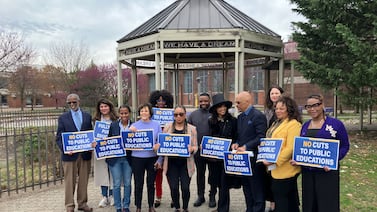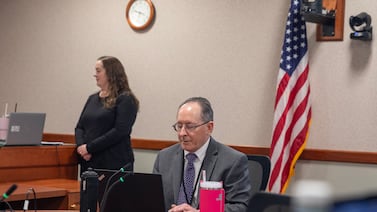When Colorado education officials stepped in and ordered new management in the Adams 14 school district, it was the first time the state asserted its authority under decade-old accountability laws.
The hope — although there were skeptics from the start — was that state oversight and an outside management company would provide stability after constant turnover, and coupled with added resources, would raise student achievement in a district with some of the lowest test scores in the state.
Less than four years after the mandate, the experiment in state intervention is crumbling as the district’s new superintendent has wielded her own powers while the local board is pushing out the management company — and fears remain that students still don’t have access to an adequate education.
State officials failed to mediate the leadership conflict and, with limited options, the State Board now has floated the possibility of dissolving the district. State law is unclear on how that would happen or what would come next.
The crisis in Adams 14 raises questions about the state’s ability to rescue the most troubled of school districts, about what kind of oversight system would work, and about what success would look like.
Some State Board members say the law needs to give them more authority, while some community members prefer the state to stay out except to provide more resources to address problems like poverty and hunger that impede learning.
Education Commissioner Katy Anthes defends the state accountability system, despite her disappointment in how things have played out in Adams 14.
“This can work,” Anthes said. “Providing extra support, focus and expertise can and does work to improve schools and improve student outcomes. We do see this instance where it’s more challenging, but we do see a lot of great things happening.”
Colorado is not alone in struggling. Around the country, state takeovers have a poor track record, especially in the long run, making it hard to find models for success. One thing they have in common, though, is turnaround efforts occur in districts that serve mostly students of color and those districts often end up stigmatized and labeled as failures.
“If you look at the data on these kinds of turnaround takeover efforts, it’s a complete mixed bag so we really still don’t know if these kinds of reforms are good or bad,” said Jonathan Collins, an assistant professor of education and international and public affairs at Brown University. “What we do know is they tend to be racialized.”
Being on the clock
Colorado’s school accountability system rates schools and districts based on standardized test scores and calls for intervention in schools that don’t improve over time. Schools or districts are referred to as being on the clock because they have to improve before time runs out. A low performance rating qualifies schools and districts for state grants and resources from the Department of Education to improve.
The State Board of Education taps experts who visit the schools or districts and issue recommendations. District leaders also can present their own improvement plans which the board often approves — or it can order something else.
But the state has limited ways to intervene. Among its options, it can shut down schools, dissolve districts, turn schools into charters, or order an outside management partner to take over some or all of the operations of a school or district.
In Colorado, unlike in many other states, the state cannot just take over a struggling district.
In 2010, 24 districts were on the state’s watchlist for low performance, but most have improved. In 2019, the most recent year for ratings, there were just three districts on state watch. Some of the districts that have improved enough to be off the list still have considerably low test scores.
Anthes, the education commissioner, said that every situation is unique but that department staff have learned that relationships are important, and that being really clear in guidance is, too.
“What we’ve seen from other districts is that the partnership between the district, CDE, and whatever the management partner is, is really important,” Anthes said. “We’re all human beings in this hard work of turnaround, so having good trusting relationships between those entities is important.”
Adams 14 has been on the state’s radar for more than a decade. Three years ago when it handed over daily management authority to a private, for-profit company, some say the state and the district failed to clearly spell out the division of authority.
“We really struggled with entering into an agreement. What is MGT responsible for providing to the district, versus what is the district still responsible for? That is the main area of conflict,” said state Sen. Dominick Moreno, a former Adams 14 school board member. “I don’t think it was all that clear what the responsibility of each respective entity was.”
The latest school board vote would have terminated the contract with MGT Consulting in April, when the State Board is expected to consider new orders for Adams 14. On Friday, MGT Consulting told district officials the company would end its work in the district effective Feb. 11.
The Adams 14 school district serves about 6,100 students, the majority of them Hispanic students. The district also has one of the highest proportions of English language learners in the state. Until recently, the district struggled with complying with a federal order issued after an investigation found leaders had been discriminating against Hispanic students and staff, and not providing the right education to help students learn English.
Enrollment has declined for years, worsening at times as staff changed and the district embraced one turnaround strategy after another.
First district to lose control to a private company
As the state stepped in to stabilize and strengthen leadership, state law hobbled its efforts. The outside manager, MGT Consulting, still had to report to the Adams 14 school board.
But State Board members tried to make clear that they wanted the local school board to follow MGT’s recommendations and to justify rejecting any of them.
The first couple years saw positive reports about MGT’s work in the district, which included coaching principals, updating curriculum, and securing federal approval for a new plan to serve English learners.
MGT’s proposal always had called for the local board to hire its own superintendent halfway through the 4-year plan. But neither the state nor MGT outlined how they would start to hand over authority. After the Adams 14 board hired Karla Loria as superintendent last spring and she tried to assert her authority, the relationship quickly fell apart.
Loria said in a recent press conference that she thought it was clear that she would work side by side with the management company. She now wants the state to allow her to oversee the work of any management partner, not the other way around.
But having a superintendent come in after a management company might not be the right sequence for success, said Mary Wells, co-founder and managing partner for the nonprofit Bellwether Education Partners.
“It does sound like a really challenging structure,” Wells said.
Allowing district leadership to select the external manager might make leaders more invested in the work, she said. “Then that superintendent would be much better positioned to hold that organization accountable.”
The Adams 14 local board did select MGT, but only after the state rejected the community’s first choice. The State Board, aware that the community’s second choice was MGT, had raised concerns about the for-profit company too, but approved the choice after the local board selected MGT in a meeting with no discussion.
None of those voting members remain on the Adams 14 board today.
State Board member Steve Durham believes that the problem is whether the local board has an interest in working with a management partner.
“We all had high hopes that this would work,” Durham said. “I think the problem is the external manager model won’t work unless you have a board of education that is committed to working with the external manager that they selected.”
At a meeting last month, Durham wondered about changing the law to allow the State Board to take more of the local board’s authority away.
Current Adams 14 board members have publicly stated that they became disheartened by what they describe as MGT’s failure to deliver on promises.
But the board has refused to make public much of the evidence they claim to have collected against the company, and MGT officials deny any wrongdoing.
“We’ve found the Colorado Department of Education to be consistent and committed partners in supporting Adams 14,” Eric Parish, MGT executive vice president, said in an emailed statement, adding that CDE had monitored the company’s work closely and he believes the company’s record speaks for itself.
Holding companies accountable
With the relationship at the top unraveling last fall, the State Board briefly yanked the district’s accreditation, an action that had little practical effect, but was meant as a consequence for failing to negotiate an agreement to restart work with MGT. But the State Board had no power to punish MGT for failing to reach a deal. Community members and at least one State Board member pointed out the dilemma of the state not being able to hold a private company accountable.
As the district and the company negotiated, State Board member Rebecca McClellan questioned if Adams 14 was at a disadvantage.
“We are placing them right back in the position they already were in where a private party may make demands that put them at odds with their fiduciary obligation to the taxpayers of their district,” McClellan said at a meeting in October.
Experts say that’s true in other states as well. Often districts or states can outline ways to hold a company accountable only by inserting specific language in contracts.
Jason Malmberg, the district’s teachers union president, has questioned the $7 million so far spent on the MGT contract, which essentially puts more money in consultants and advisers that he said don’t help teachers and students, despite tremendous student need.
“I’m not saying the district doesn’t need management and a functioning hierarchy, but we have buildings that aren’t meeting basic needs,” Malmberg said.
Commissioner Anthes pointed out that in the past three years, Adams 14 has received an additional $5 million in grants. State officials have spent many hours mediating problems and guiding the district.
Former State Board member Jane Goff, who represented the area and voted to approve the original state orders, said she believes in local control, but thinks the state role is to provide a lot of help.
“It’s not a good idea to just sort of take a district and say here’s what’s going to happen and then leave them on their own,” Goff said. “This is something the whole state needs to be involved in.”
Reducing poverty before focusing on test scores
Many teachers and some community members have floated the idea of creating a community school model that would flood schools with resources to address various issues that affect children’s ability to learn, such as their health, and social and emotional well being.
Several lawmakers have proposed a bill to add community school models more explicitly as one of the options that the State Board can use to intervene in a low-performing school or district.
Some experts say that as more people acknowledge that outside issues such as poverty and housing affect learning, there may eventually be support from other government departments for school communities.
“We need them to work better with school districts,” said Christine Pitts, a resident policy fellow for the Center on Reinventing Public Education. “We also need better private-public partnerships.”
The schools and districts currently on the state’s watchlist serve predominantly low-income communities, with at least 65% of their student body qualifying for subsidized lunches. Most also have much higher concentrations than the state of students with disabilities or students who are learning English as a second language, or both.
Colorado has commissioned an audit of the entire accountability system to look at whether the system is harming at-risk students more than it helps them. The audit will also look at the state’s ability to intervene and whether interventions are successful. The results of that audit are due Nov. 15.
Malmberg believes that state officials are ignoring social and outside problems that inhibit student learning. Students in Adams 14, for example, have to take standardized tests in English, even if they’re not fluent in English yet, he said, creating a language justice issue.
“From its inception the testing regime that they put in place destined us to failure,” Malmberg said. “They’re assuming the ground rules that have been laid are equitable. There was no other outcome than supposed failure.”
Commissioner Anthes said that while she understands that view, she believes that the state’s accountability system is not targeting, but identifying communities that just need more help.
“It can shine a light on folks who may need additional support, additional professional development, additional resources or programming for students,” Anthes said. “We want to make sure they get whatever they need.”
Searching for consistency
Parents in Adams 14 have voiced distrust in the district for years, in part because of the instability of leadership, and recently over day-to-day decisions such as whether school will be remote or in person the following day. Some parents who have become more engaged with the current superintendent and have renewed hope for improvement say the state is not listening to them.
Malmberg says that teachers stand behind the district’s new leaders. He’s not sure he would have been as confident in previous boards, but now believes the leaders are listening to the community.
“We have the right people but they’re not able to make decisions,” Malmberg said.
That brings a main issue back to the state — of how much it should remain involved and what entity should wield power.
Collins of Brown University said while often the need to remove ineffective leaders is clear, how to bring in more effective leaders — and to ensure they stay for a long time — is not. Constant change remains one of the biggest challenges for sustained improvement.
“There needs to be clear guidelines and a clear outline of how this is going to generate consistency and continuity,” he said. “We don’t typically see that.”




